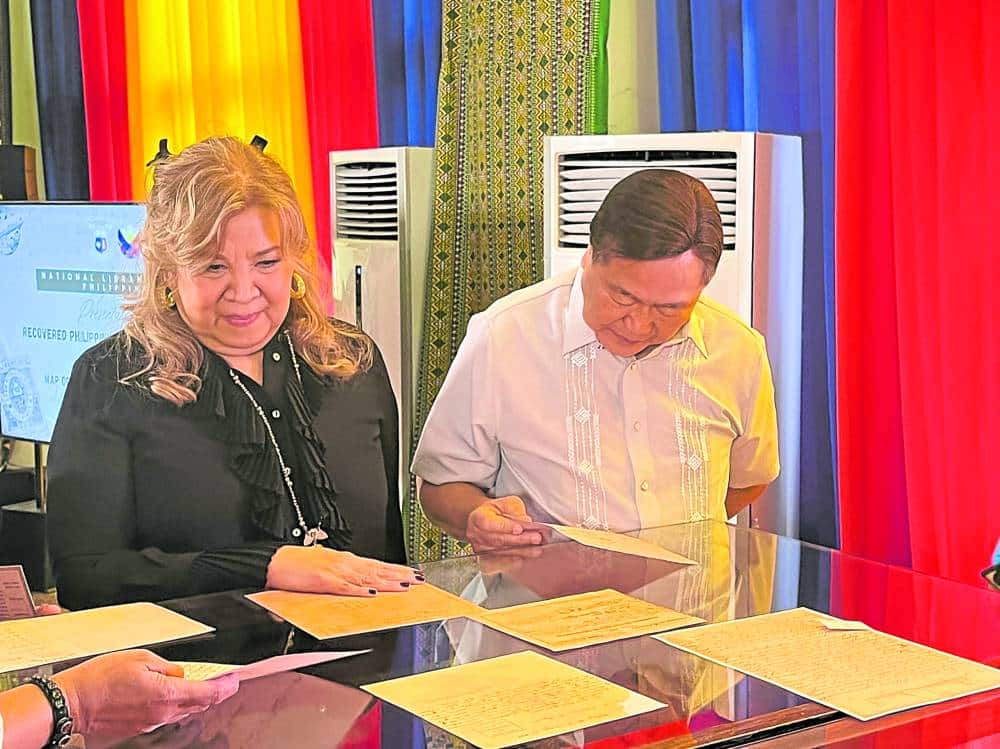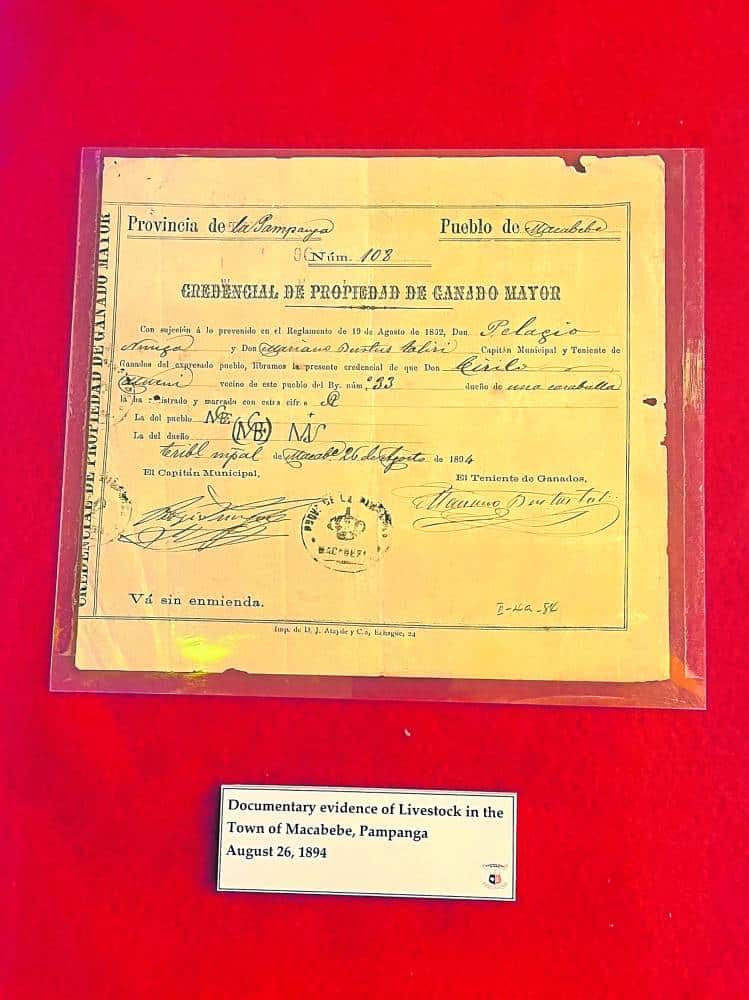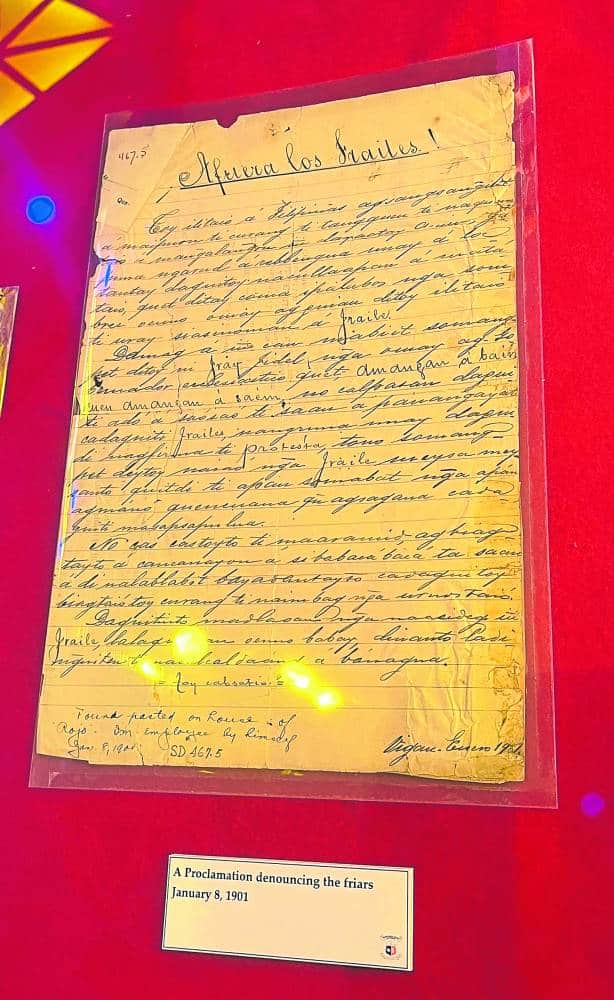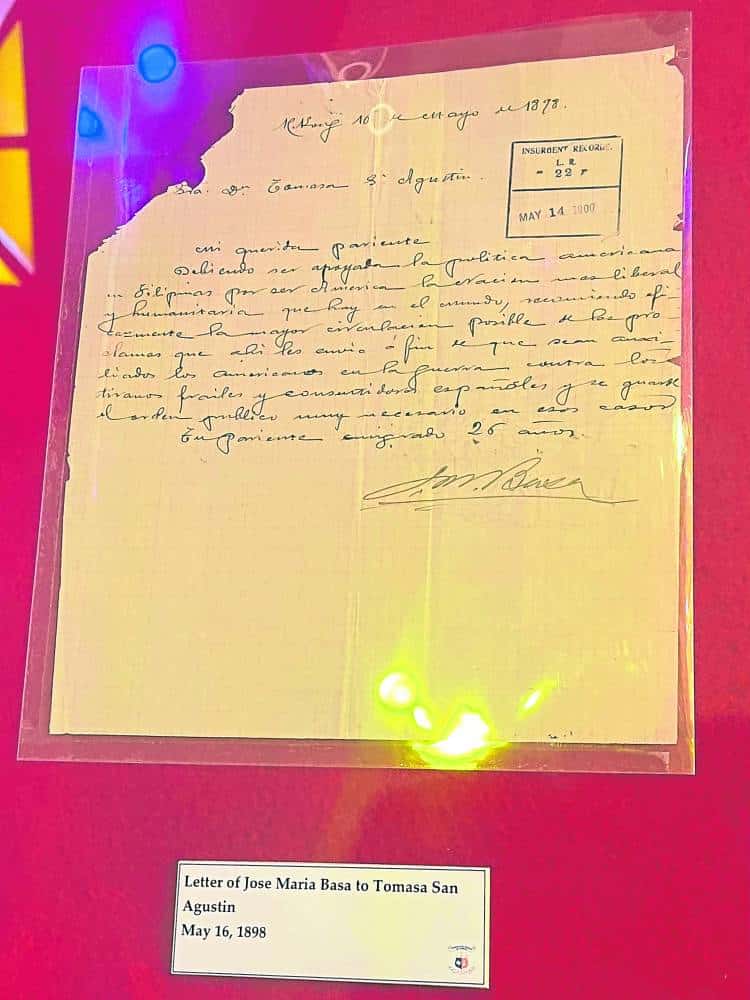pwbet gaming Missing pages of PH history found, nearly sold for P44,000


HISTORICAL DOCUMENTS Former National Historical Commission of the Philippines Chair Lisa Guerrero Nakpil and retired Senior Associate Justice Antonio Carpio examine the seven stolen revolutionary documents now on display at the Permanent Gallery of the National Library.
MANILA, Philippines — On Oct. 16, around 10 p.m., National Library of the Philippines (NLP) Director Cesar Gilbert Adriano received a text message from former National Historical Commission of the Philippines Chair Lisa Guerrero Nakpil: three missing revolutionary documents that were part of the Philippine Insurgent Records (PIR) were on sale on eBay.
These were the 1898 correspondences of Eugenio Daza, a hero of the Balangiga encounter; letters from Teodoro Sandico, a member of President Emilio Aguinaldo’s Cabinet; and Ladislao Diwa, cofounder of the Katipunan—records that were seized by the United States and returned to the Philippines in 1957 but were stolen sometime between the 1980s and 1990s.
Article continues after this advertisementThe sale was discovered by Jim Richardson, an independent researcher, who posted about it on Facebook and then notified Nakpil.
FEATURED STORIES NEWSINFO PMA: 764 female military officers owe careers to Rasul NEWSINFO ‘2022 presidency was mine already’ – VP Duterte NEWSINFO Bonifacio Day protest: 1 cop hurt, 1 activist arrested in MendiolaREAD: Ancient maps and the rise of a nation
Based on Richardson’s post, the historical documents were being sold for around $749.95 (approximately P44,000).
Article continues after this advertisementThe NLP immediately contacted the seller while the staff at the Filipiniana section worked to verify that the documents were indeed part of the PIR.
Article continues after this advertisementFortunately, in addition to the three documents, the seller surrendered four more documents. The items were proven to belong to the PIR.
Article continues after this advertisement

The seven stolen documents, now housed in the NLP’s Permanent Gallery alongside manuscripts of Dr. Jose Rizal’s “Noli Me Tangere,” “El Filibusterismo,” and “Mi Último Adiós” as its centerpiece.
Article continues after this advertisementIn a simple ceremony on Nov. 25, historian Ian Christopher Alfonso from the NLP’s special projects discussed the seven documents in detail. The first is the Feb. 2, 1899, letter of Cavite revolutionary Gov. Ladislao Diwa regarding local affairs in Santa Cruz, Lubang Islands in Mindoro.
Alfonso noted that the orthography used for Cavite during this time was “Kavite,” reflecting an early effort to align Tagalog orthography with native phonetics during the revolution.
Another interesting document is Jose Ma. Basa’s letter, written in Hong Kong on May 18, 1898, to his relatives in Manila (addressed via a certain Sra. Tomasa San Agustin), assuring them that the Americans were “friends” and “righteous.”
Another document, posted on the house of a certain Mr. Rojo in Vigan, was retrieved on Jan. 8, 1901. It had a Spanish title: “Afuera los frailes!” (Out, Friars!) with text in Ilocano.
Alfonso said that John Taylor, who was then in charge of the PIR, made an annotation that the document seemed to be a manifesto by an Ilocano against the friars.
The four other retrieved documents were a travel certificate for various individuals issued by Daza from the Capitania de la Administracion Militar; a telegraph to US President William McKinley transmitting Basa’s message to wealthy and educated Filipinos to support America; a registration certificate issued to Don Cirilo Musni for his “caraballa” (female carabaos) with “cifras” (cyphers); and a Jan. 16, 1899, report from Sorsogon revolutionary Gov. Celestino Mercado to the interior secretary about postal revenues.


One of the stolen insurrection records rescued from eBay. —Photos by Jane Bautista
Public’s help soughtAlfonso hoped that these seven documents would be returned to their respective bundles.
Adriano, for his part, committed to actively searching for other lost PIRs and appealed for public assistance in recovering these valuable records. “We guarantee that the handover will not cause you any kind of inconvenience, and we will not hold you responsible,” he assured collectors who may have the other stolen documents.
After presenting the seven stolen insurrection records, the NLP unveiled the Philippine map attached to the 1898 Treaty of Paris, which marked the formal cession of the Philippines from Spain to the United States, ending Spanish rule and beginning American colonization.
Despite the establishment of the Philippine nation, NLP historian Xiao Chua said the Spanish refused to surrender to Filipinos and opted to surrender to the Americans instead. This led to negotiations in Paris, where the United States agreed to pay Spain $20 million.
“The Americans argued that this wasn’t a sale but a payment for the developments Spain had made in the Philippines. This payment and the map used in the Treaty of Paris were part of the agreement,” Chua said.
‘Four Maps’ project

The map, donated by retired Supreme Court Associate Justice Antonio Carpio, is part of his personal initiative called the “Four Maps” project, which involves acquiring and donating to the National Library four maps that establish Philippine sovereignty.
The first, the 1734 Pedro Murillo Velarde map donated by businessman Mel Velarde, shows that Panatag (Scarborough) Shoal and the Spratlys were part of Philippine territory.
The new map, attached to the 1898 Treaty of Paris, is “incomplete” and “erroneous” as it does not include Panatag Shoal and other islands of the Spratlys within Philippine territory.
While the map misled many countries—including China, which, during arbitration at The Hague, submitted a position paper claiming that Philippine territory was limited to the islands within the Treaty of Paris lines—Carpio said it was still “very important” as it explains the less famous supplemental treaty called the “Treaty of Washington” in 1900.
The Treaty of Paris defined Philippine boundaries by geographical coordinates, but the territories of Cagayan de Sulu and Sibutu were not clearly included.
Carpio noted that the Spanish garrison in these areas refused to move because they were not part of the cession.
“The Americans had to go back to the Spaniards to negotiate another treaty to clarify that Spain ceded to the United States all the islands of the Philippine archipelago, including those lying outside the line,” he said.
Subscribe to our daily newsletter
The text of the Treaty of Washington specifically states that Spain ceded to the United States “any and all islands belonging to the Philippine archipelago lying outside the lines.” The United States paid an additional $100,000 to Spain for that.
“This is the value of this map. It triggered the signing of that second treaty,” Carpio said.
Those who have information on missing Philippine Insurgent Records can call the NLP via (+632) 5314-2100, local 131 or 0917-8718228pwbet gaming, or email [email protected].
READ NEXT Aquino kin: Keep Ninoy, Edsa out of Marcos-Duterte feud PHLPost features Christmas in world’s longest postage stamp EDITORS' PICK Aquino kin: Keep Ninoy, Edsa out of Marcos-Duterte feud PMA: 764 female military officers owe careers to Rasul Argentina promotes world-class beef at exclusive tasting event in Manila HOLIDAY SEASON: How to celebrate Christmas on a budget? 18-day-old Philippine eagle chick dies, says foundation France accuses countries of ‘obstruction’ at plastic talks MOST READ BARMM polls postponement should undergo plebiscite – lawyer PMA: 764 female military officers owe careers to Rasul Pagasa forecasts rainy weather for Sunday in most parts of the country Marbil on filing raps vs Sara Duterte: People must not say PNP is afraid Follow @FMangosingINQ on Twitter --> View comments


